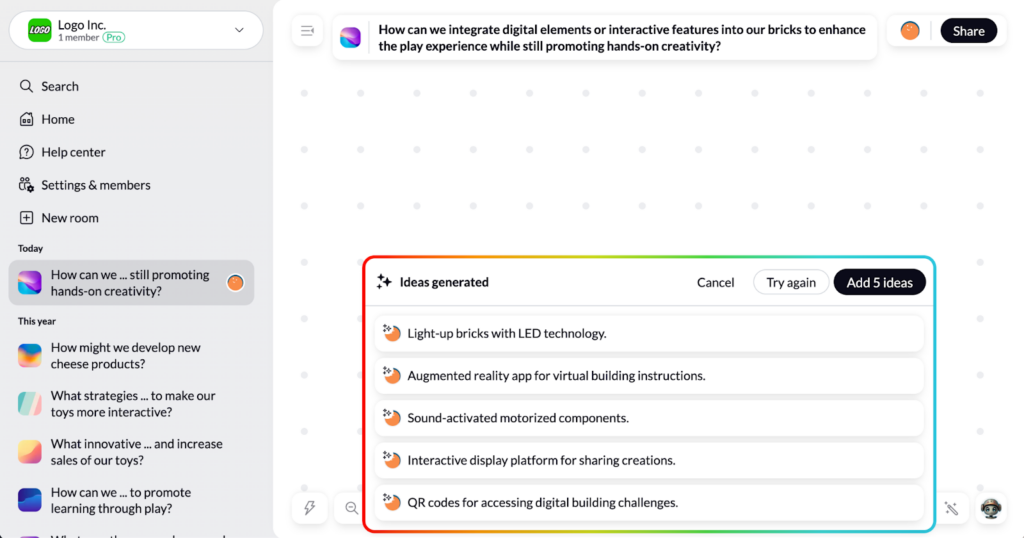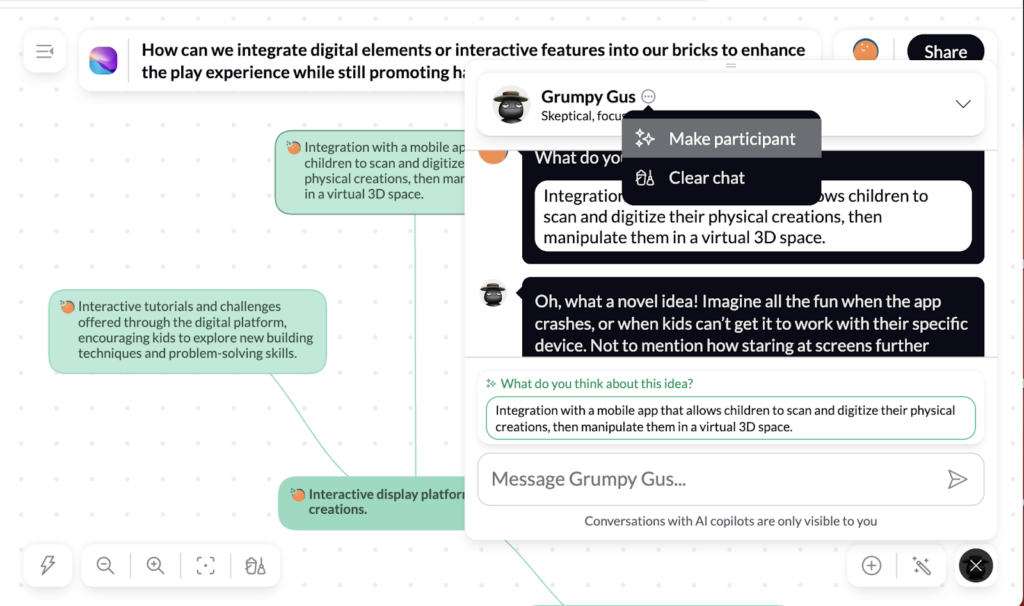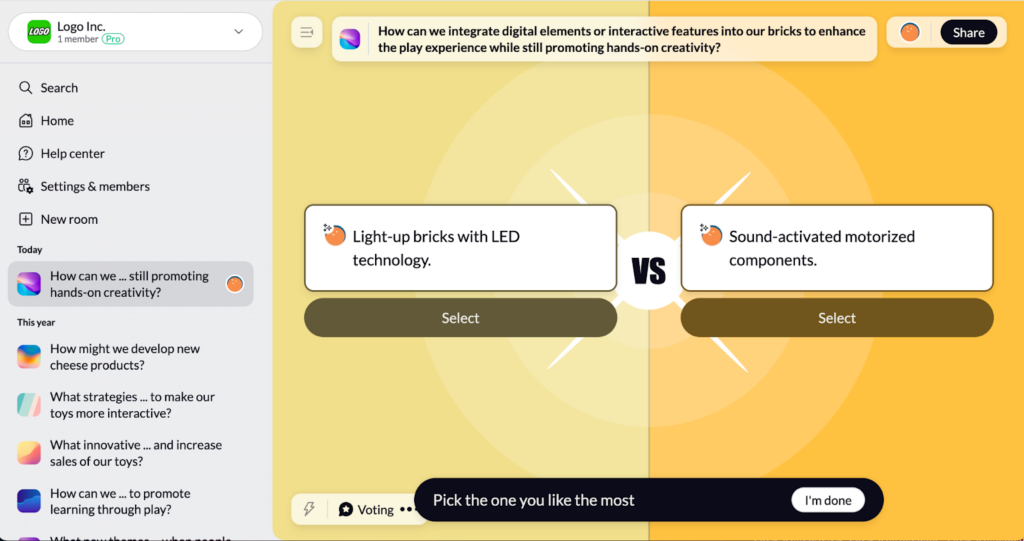Welcome to this edition of our Tools for Thought series, where we interview founders on a mission to help people make the most of their minds. Jakob Storjohann is the CEO and founder of Ideamap, which is part of Ideanote. Ideamap is a visual workspace for brainstorming where teams collaborate on ideas and use AI to boost their creativity.
In this interview, we talked about the relationship between AI and creativity, how to foster collaborative creativity, the integration of AI with human ingenuity in brainstorming, the role of AI in organizing ideas, the importance of high-quality feedback in the creative process, and much more. Enjoy the read!

Hi Jakob, thanks for agreeing to this interview! What inspired you to help people brainstorm better?
Honestly, it all started because seeing ideas lost in the slog of old, inefficient systems was painful. Our co-founders, the Mehlsen twins, experienced too many brilliant thoughts getting stuck in bureaucracy. So, it started from the perspective of wanting to make ideas matter. And Excel sheets were not the answer.
That really led us to try to make working with ideas so simple that we could democratize both the tools and the knowledge of how to innovate. We’ve now built Ideanote, an ultra-efficient idea management platform for businesses of all sizes.
We enjoy working with ideas – and everyone we meet likes ideas – but only if we make working with them simple and time-saving enough. Only then can more of them matter across the board. For that one big brand, government agencies, and even your team.
We invested early in making AI a part of Ideanote, but at some point, I just had to call it off and say, listen, I don’t know where the AI will lead us. We need a place for experimentation. So we took our time, and what became our AI Brainstorming experiment is now called Ideamap.
This is exciting. How do you think AI can support creativity?
It’s one of the most surprising twists isn’t it? If you try to travel back five years and talk about AI, most people said: Sure AI can automation can take menial tasks, but they can’t be creative. Turns out that’s literally what they’re best at.
ChatGPT can’t be sure of its facts, but with the right instructions, it can draw on inspiration from, well, anywhere from Napoleon to Platypus to Non-Newtonian fluids. And what is really setting fire to creativity if not inspiration and diverse thought?

Sure, AI has a bias, just as our knowledge has, but the sheer breadth and depth of knowledge can inspire anything from a brainstorming session about the next location for your local soccer tournament to new ways of curing diseases.
We see AI as a friendly buddy, a sidekick that can help you be a brainstorming partner, and that’s also how we’ve designed Ideamap.
How does Ideamap help ideas and AI come together?
Ideamap is a cutting-edge tool where AI and human creativity kind of reinvent brainstorming. It stands out by providing a visually engaging and structured space that prompts creative collaboration for teams and even if you are alone, trying to come up with ideas.
Here, AI doesn’t just mimic humans, you could say it elevates it: with instant idea generation, automatic idea categorization, AI Actions and interactive AI Copilot. It’s AI from the ground up.
It’s very much designed to be a massive time-saver across the board. From ice-breakers at the beginning to not having to sift through ideas by your own to sort them to visualizing them or summarizing them en masse.
On top of that it is focused on brainstorming sessions. So, facilitating advanced idea rating sessions like a dot matrix or elo rating is one click. Summarizing the brainstorming session is one click. Templates like SCAMPER or the Disney Method are also just one click away for all of your ideas.
You can think of it as an endless canvas where your team’s creativity is amplified by AI co-pilots, who not only generate fresh concepts but also organize and refine them. It’s a brainstorming sidekick for your team.
You also have developed some inbuilt AI tools to help people brainstorm faster.
Yes! The platform comes with a ton of super useful templates and AI Actions and copilots but it gives you all the power to create your own ways of working with ideas.
So, if you’re a Content Marketer you can create a brainstorming workflow with 3 custom AI Actions that let’s you generate 5 Pillar Articles, then 3 Sub-Articles and 5 Headlines per Article in one visual canvas.
Or, when working with AI Copilots you can make your buyer personas into copilots and let them give feedback on your ideas organically.
Another important part of brainstorming is high-quality feedback.
Absolutely. I think sometimes we’re all faced with the fact that we are a little afraid of feedback. We’ve built something nice or we’re thinking in one direction and we’re wondering, does this hold up?
With only our own perspective it can sometimes be hard to brainstorm. It’s just not natural to keep being your own devils’ advocate or hype man or fact checker. We can’t have that many hats on. But AI can.
So if you have a mindmap of ideas laid out in Ideamap you can invite Grumpy Gus, our grumpiest copilot and really see things from a different perspective without having to do 4D chess with yourself when brainstorming.

How does Ideamap facilitate collaborative creativity?
Ideamap is all about boosting creative collaboration, especially for remote teams. We understand that distance can sometimes dampen the brainstorming spark, so we’ve crafted a real-time, infinite canvas where teams can come together no matter where they’re located.
Teams can now work side-by-side on the same digital whiteboard, adding, refining, and developing ideas as they flow. Real-time collaboration means no lag, no lost ideas, just seamless exchange and building on each other’s creativity.
For structured sessions, Ideamap’s facilitation features help you turn ideation sessions more actionable. When it’s time to make decisions, the voting system simplifies prioritizing ideas, making it faster to identify the gems. Plus, automatic summaries make ideation sessions more actionable, faster.

In short, Ideamap brings the energy of in-person ideation sessions to remote teams, ensuring that distance doesn’t hinder creativity but rather opens up a world of collaborative potential.
The problem with many brainstorming tools is that you can find yourself locked into the tool.
Ideamap is designed with the philosophy that your ideas should never be captive to a single platform. We understand that collaboration and implementation often span across different tools and environments.
You can easily share your brainstorming sessions with anyone using shareable links or embed them directly onto websites. For those who work within other productivity suites, Ideamap offers smooth integrations, like with Microsoft Teams, so that you can incorporate brainstorming into your existing workflow without missing a beat.
Importing from and exporting to other applications is a snap. You can pull in existing data with a simple CSV import to jumpstart your sessions with pre-existing insights. Conversely, when you’re ready to take your ideas to the next stage, exporting is just as effortless—be it as a CSV for data crunching, an XLSX for further analysis, or into presentation formats to share your vision with stakeholders.
By ensuring Ideamap fits intuitively into your broader toolkit, ideas are free to move and evolve beyond the brainstorming phase, fully realizing their potential wherever they’re needed.
What kind of people use Ideamap?
It’s really useful for freelancers, consultants, students and solo entrepreneurs that might not have a team to rely on for playful diversity of thought. A sounding board if you will.
But it is equally lifting up the productivity of brainstorming sessions for your typical product team that wants maximum creativity during product strategy planning.
Every role and every team really brainstorms. Ideamap just comes with inbuilt AI templates and facilitation tools that speed the whole process up.
What about you, how do you use Ideamap?
We’ve even realized ourselves that we have changed the way we brainstorm as we were developing Ideamap: turns out it’s much faster to let AI generate some topics and ideas just to get everything kickstarted. Way less awkward and way faster.
So, boom, generate ice-breakers, generate topics, generate three ideas per topic in 10 seconds, and suddenly, we have a more neutral ground on which we can start talking about opinions, feelings, and ideas. It kickstarts the whole process and lets the ideas flow.
The challenge generator that helps us create “how-might-we” type questions has also been a source of inspiration in terms of what challenges we could address.
How do you recommend someone get started?
Getting started with Ideamap is straightforward and rewarding from the get-go. First, sign up for a free account on our website. You’ll instantly gain access to your own workspace. From there, AI will already generate some brainstorming “rooms” with topics that match your business or interests.
A quick way to experience the magic is to step into one of those rooms and just generate about 20 ideas and then hit “AI Group into Topics.” You’ll experience those aha moments as you see ideas being generated and automatically categorized into topics before your eyes.
Clicking on the idea to let AI visualize it is another one of those experiences.
Next up is inviting your team via a shareable link. Just click share and post that link to your work chat and let people join anonymously in a second so they and the Copilot can all build at the same time. Real-time.
Then, try out the comparative voting. Click the facilitation button, then choose from the voting options. We’ve put some work into making it nearly a game-like experience.

Ideamap is very visual and clean. For now, people describe it as quite intuitive to get the hang of. Adding ideas, adding your teammates, and letting a Co-Pilot build on your ideas. It’s all very straightforward. But if it isn’t, let us know! We’ll fix it!
And finally… What’s next for Ideamap?
We’re really here to make more ideas matter in those big and small moments. For freelancers and big organizations alike. And we’re really excited about how fun it is to let AI help us get closer to that vision.
So far, it’s been a blast building Ideamap, and it is fun using it. We’ll invest more time into really fine-tuning how well the AI understands the context. We’ll also aim for Ideamap to continue to be playful and fun. It’s where ideas are having their best time, and it’s where I feel at home. The world needs more fun and more people working on ideas with their fullest creative potential.
Thank you so much for your time, Jakob! Where can people learn more about Ideamap?
Ideamap.ai has plenty of how-to’s on ideation, brainstorming and using AI to up your creativity. We also have a community that you can join. We’re definitely always open for a chat with fellow people who care about ideas.
